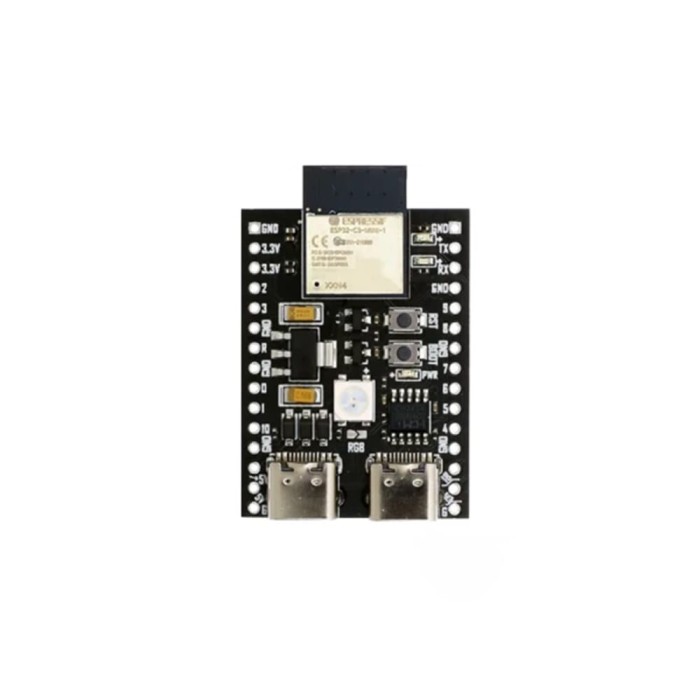ESP32-C3 development board
 Espressif ESP32-H2-DevKitM Development Board
Previous
Espressif ESP32-H2-DevKitM Development Board
Previous

The ESP32-C3 development board is a powerful and versatile board for all your IoT and wireless projects. With its compact size and easy installation, this board provides a seamless and reliable connection to the internet or local network. It has a high-performance microcontroller and supports both Wi-Fi and Bluetooth connectivity, making it suitable for a wide range of applications.
Equipped with a 2.4GHz Wi-Fi and Bluetooth 5.0 module, the ESP32-C3 development board offers fast and stable wireless communication. It also has a built-in memory and supports external flash memory, providing enough storage for your projects. With its affordable price and versatile use, this board is a top choice for all your IoT and wireless needs. Upgrade to the ESP32-C3 development board and unlock endless possibilities for your projects.
Key features of ESP32-C3-MINI development board
- ESP32-C3 is a secure, stable, low-power, low-cost IOT chip equipped with RISC-V32-bit single-core processor, supporting 2.4GHz Wi-Fi and Bluetooth 5 (LE). Provide industry-leading RF performance, complete security mechanism and rich memory resources for iot products.
- ESP32-C3's dual support for Wi-Fi and Bluetooth 5 (LE) reduces the difficulty of device distribution and is suitable for a wide range of iot application scenarios.
- ESP32-C3 is equipped with RISC-V 32-bit single-core processor, clock rate up to 160 MHz. It has 22 programmable GPIO pins and 400 KB built-in SRAM, and supports multiple external flash interfaces through SPI, Dual SPI, Quad SPI, and QPI, meeting the functional requirements of various iot products. In addition, the high temperature resistance of the ESP32-C3 also makes it ideal for lighting and industrial control.
- The ESP32-C3 integrates 2.4GHz Wi-Fi and Bluetooth 5 (LE) with long range support to help build iot devices with greater coverage and RF performance. It also supports the Bluetooth Mesh protocol and Wi-Fi Mesh, maintaining excellent RF performance at higher operating temperatures.
- ESP32-C3 supports secure startup based on RSA-3072 algorithm and flash encryption based on AES-128-XTS algorithm to ensure secure device connection; Innovative digital signature module and HMAC module ensure device identity security; Hardware accelerators that support encryption algorithms ensure that devices securely transfer data on local networks and in the cloud.
- ESP32-C3 follows the mature Internet of Things development framework ESP-IDF. ESP-IDF has successfully enabled hundreds of millions of iot devices and has gone through rigorous testing and release cycles. Based on its mature software architecture, familiarity with apis and tools will make it easier for developers to build or migrate ESP32-C3 applications.
- The ESP32-C3 also works in slave mode, providing wi-Fi and Bluetooth LE connectivity to the external host MCU through ESP-AT and ESP-Hosted SDK.
Specification of ESP32-C3-MINI development board
-
General
- ESP32-C3FN4 embedded, 32-bit RISC-V single-core processor, up to 160MHz
- 384KB ROM
- 400KB SRAM
- 8KB RTC SRAM
- 4MB SPI Flash
- 3.0V to 3.6V operating voltage/power supply
- –40 to 85°C operating temperature range
-
WIFI
- Support IEEE 802.11blg /n protocol ·
- Supports 20 MHz and 40 MHz bandwidth in the 2.4 GHz band
- Supports 1T1R mode with data rates up to 150 Mbps
- Wireless Multimedia (WMM)
- Frame aggregation (TX/RX A-MPDU,TX/RX A-MSDu)
- Immediate BlockACK
- Fragmentationand defragmentation
- Transmit opportunity (TXOP)
- Beacon Automatic Monitoring (Hardware TSF)
- 4x Virtual Wi-Fi interface
- It also supports infrastructure networks
- (Infrastructure BsS) Station mode, SoftAP mode, Station +SoftAP Mode and Hybrid mode Please note that the SoftAP channel changes simultaneously when the ESP32-C3 series chip is scanned in Station mode
- Antenna diversity
- 802.11mcFTM supports external power amplifiers
-
Bluetooth
- Bluetooth Low Energy (BT LE):BT 5, BT mesh
- High Power mode (18 dBm)
- Rates support 125 Kbps, 500Kbps, 1 Mbps, 2 Mbps· Advertising Extensions
- Multiple Advertisement Sets
- Channel Selection Algorithm #2
Wi-Fi and Bluetooth coexist, sharing the same antenna
- CPU and Storage:
- 32-bit RISC-V single-core processor, up to 160 MHz
- CoreMarkR score:
- Single-core 160MHz:407.22
- CoreMark; 2.55
- coreMark/MHz
- 384 KB ROM
- 400 KB SRAM(16 KB of which is dedicated to cache)
- 8KB RTC SRAM
- Advanced peripheral interfaces and sensors:
- 22 x GPIO port
- Digital interface: 3x SPI, 2x UART, 1x l2C, 1xl2S
- Infrared transceiver, 2 transmit channels and 2 receive channels
- LED PWM controller with up to 6 channels
- Full speed USB serial port /JTAG controller
- Universal DMA Controller (GDMA), 3 receive channels and 3 transmit channels -1 x TWAIR controller, compatible with IS011898-1 (CAN Specification 2.0)
- Analog interface
- 2 x12 bit SAR analog/digital converter with up to 6 channels
- 1x Temperature sensor
- Timer
- 2 x54 bit universal timer
- 3x Watchdog timer
- 1x52 bit system timer
- Low power Management: Power management unit, four power consumption mode security mechanism
- Safe start
- Flash encryption
- 4096 bit OTP, up to 1792 bits available
- Encryption Hardware Accelerator:
- AES-128/256 (FIPS PUB 197)
- Access rights management
- SHA Accelerator (FIPS PUB 180-4)
- RSA accelerator
- Random Number Generator (RNG)
- HMAC· Digital signature



Please complete your information below to login.
Sign In
Create New Account